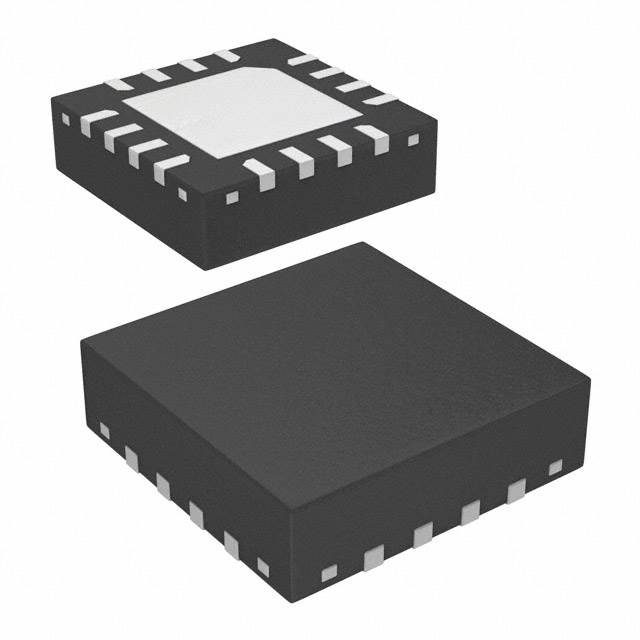ADXL335BCPZ-RL7
Product Overview
The ADXL335BCPZ-RL7 belongs to the category of accelerometers and is commonly used for measuring acceleration in various electronic devices. This sensor is known for its small size, low power consumption, and high sensitivity, making it suitable for a wide range of applications. The ADXL335BCPZ-RL7 is typically packaged in a small, surface-mount package and is available in quantities suitable for both prototyping and production.
Specifications
- Operating Voltage: 1.8V to 3.6V
- Sensitivity: 350 mV/g
- Bandwidth: 0.5 Hz to 1600 Hz
- Temperature Range: -40°C to +85°C
- Package Type: LFCSP (Lead Frame Chip Scale Package)
Detailed Pin Configuration
The ADXL335BCPZ-RL7 features a total of 16 pins, including power supply, ground, and analog output pins. The pinout configuration is as follows: 1. VCC 2. GND 3. XOUT 4. YOUT 5. ZOUT 6. ST 7. NC 8. NC 9. NC 10. NC 11. NC 12. NC 13. NC 14. NC 15. NC 16. NC
Functional Features
- High Sensitivity: The ADXL335BCPZ-RL7 offers high sensitivity, allowing it to detect even subtle changes in acceleration.
- Low Power Consumption: With its low power requirements, this accelerometer is suitable for battery-powered applications.
- Small Form Factor: The compact size of the ADXL335BCPZ-RL7 makes it easy to integrate into various electronic devices.
Advantages and Disadvantages
Advantages
- High sensitivity
- Low power consumption
- Small form factor
Disadvantages
- Limited measurement range compared to some other accelerometers
- Analog output requires additional signal conditioning for precise measurements
Working Principles
The ADXL335BCPZ-RL7 operates based on the principle of capacitive sensing. It consists of a microelectromechanical system (MEMS) structure that measures the capacitance changes caused by acceleration. These changes are then converted into analog voltage outputs proportional to the applied acceleration.
Detailed Application Field Plans
The ADXL335BCPZ-RL7 finds extensive use in various applications, including: - Motion detection in consumer electronics - Tilt sensing in industrial equipment - Vibration monitoring in automotive systems - Impact detection in sports and fitness devices
Detailed and Complete Alternative Models
Some alternative models to the ADXL335BCPZ-RL7 include: - ADXL345: Offers digital output and higher resolution - MMA8452Q: Provides digital output and lower power consumption - LIS3DH: Features digital output and ultra-low power mode
In conclusion, the ADXL335BCPZ-RL7 accelerometer offers high sensitivity and low power consumption, making it suitable for diverse applications in consumer electronics, industrial equipment, automotive systems, and sports devices. While it has limitations in terms of measurement range and analog output, there are alternative models available with different features to suit specific application requirements.
Word Count: 410
قم بإدراج 10 أسئلة وإجابات شائعة تتعلق بتطبيق ADXL335BCPZ-RL7 في الحلول التقنية
What is the ADXL335BCPZ-RL7 accelerometer used for?
- The ADXL335BCPZ-RL7 is a low-power, 3-axis accelerometer that can be used to measure acceleration in various technical solutions.
How do I interface the ADXL335BCPZ-RL7 with a microcontroller?
- You can interface the ADXL335BCPZ-RL7 with a microcontroller using analog voltage outputs or by using an analog-to-digital converter (ADC) if digital readings are required.
What is the operating voltage range of the ADXL335BCPZ-RL7?
- The ADXL335BCPZ-RL7 operates within a voltage range of 1.8V to 3.6V.
Can the ADXL335BCPZ-RL7 be used for tilt sensing applications?
- Yes, the ADXL335BCPZ-RL7 can be used for tilt sensing applications due to its ability to measure static acceleration, including the force of gravity.
What is the sensitivity of the ADXL335BCPZ-RL7?
- The sensitivity of the ADXL335BCPZ-RL7 is typically 300mV/g, allowing it to detect small changes in acceleration.
Is the ADXL335BCPZ-RL7 suitable for vibration monitoring?
- Yes, the ADXL335BCPZ-RL7 can be used for vibration monitoring applications, as it can measure dynamic acceleration caused by vibrations.
Does the ADXL335BCPZ-RL7 require external filtering for noise reduction?
- Yes, external filtering may be necessary to reduce noise in the output signal of the ADXL335BCPZ-RL7, especially in high-noise environments.
Can the ADXL335BCPZ-RL7 be used in battery-powered applications?
- Yes, the low-power consumption of the ADXL335BCPZ-RL7 makes it suitable for battery-powered applications.
What is the temperature range for operation of the ADXL335BCPZ-RL7?
- The ADXL335BCPZ-RL7 can operate within a temperature range of -40°C to +85°C.
Are there any specific mounting considerations for the ADXL335BCPZ-RL7?
- Mounting the ADXL335BCPZ-RL7 on a stable and vibration-free surface is recommended to ensure accurate measurements.


